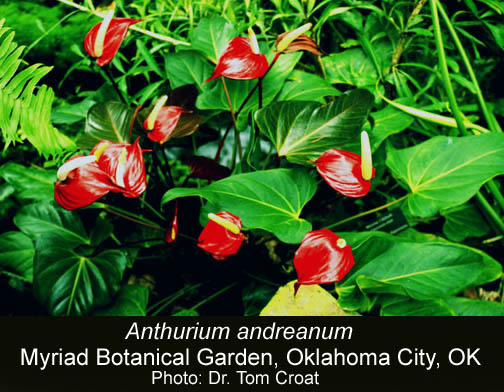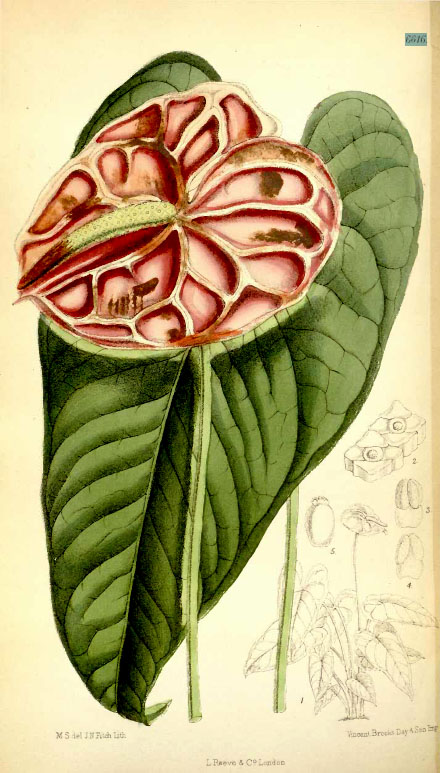![]()
Aroids and other genera in the Collection
Take the Tour Now?
Orchids
The
Exotic Rainforest
Plants in
the Exotic Rainforest Collection
The images on this website are copyright protected. Please contact us before any reuse.
Detailed information on Growing Anthurium Species
Click this Link
Within our collection we have many species of Anthurium. If you are seeking other photos, click this link:
Anthurium Obake

This Hawaiian favorite is actually used in the islands and on the U.S. mainland as a cut flower by florists. I was recently told by a local florist who visited our Exotic Rainforest they pay several dollars each for each inflorescence of Anthurium Obake to use in flower arrangements. A recent article in an Indonesian newspaper told of a young woman who ed 20,000 to be used at her wedding. Apparently, due to the inflorescence' long lasting duration, it is considered an ideal representation of love.
Obake is not a species, but instead is a cultivated
hybrid. I spent months finding that
out! I first tried botanical texts and found nothing. Then I
tried both major plant data bases (TROPICOS and the International Plant Name
Index), again finding nothing. So I
resorted to looking all over the internet and in a bunch of plant books for information on
Anthurium obake (some spell it obaki)
and kept finding only incidental notes. That was until Windy Aubrey of
Hawaii set me straight. (Windy also gave us the plant). Anthurium Obake is
a hybrid commonly grown in Hawaii. Aroid expert Leland Miyano, who was
born and raised in Hawaii, explains in more detail about the name as well as
the correct spelling,
"I am not an expert on Anthurium hybrids,
but I do know a little about the Obake Anthuriums. Notice the spelling...it
is pronounced as if it were spelled, Obakay. I do not know if there is a
registered Anthurium 'Obaki', but there are many types of Obake Anthurium
without specific names. Basically the name "obake" refers to
transformation....but it is often translated by some to, "ghost". It is a
reference to the bi-colored spathe and the often large and twisted form of
the spathe. There is no real word as obaki...so this is
 probably a
misspelling." Leland continues,
"There are so many types of Obake Anthurium that it would be a chore to name
them all at this point...some are really magnificent, however. Each one is
different and one could not collect them all. I have a friend who grows all
of his seedlings and each is a variation on the theme. There are many
backyard growers in Hawaii that do the same."
The word obake actually was derived from the Japanese
language. Leland continues,
"The word Obake is a Japanese
term...at about 1900, the sugar barons imported Japanese contract laborers
to Hawaii. Many Japanese words have come into common usage in Hawaii via
pidgin English...a broken English that was spoken by the various ethnic
groups here to communicate with each other. Today, many words from quite a
few ethnic groups have found their way into the pidgin vocabulary. Obake
has found it's way into general usage...whether one speaks pidgin or not.
In Hawaii the word is usually used for" Ghost", but in Japan,
"transformation", is a better translation."
probably a
misspelling." Leland continues,
"There are so many types of Obake Anthurium that it would be a chore to name
them all at this point...some are really magnificent, however. Each one is
different and one could not collect them all. I have a friend who grows all
of his seedlings and each is a variation on the theme. There are many
backyard growers in Hawaii that do the same."
The word obake actually was derived from the Japanese
language. Leland continues,
"The word Obake is a Japanese
term...at about 1900, the sugar barons imported Japanese contract laborers
to Hawaii. Many Japanese words have come into common usage in Hawaii via
pidgin English...a broken English that was spoken by the various ethnic
groups here to communicate with each other. Today, many words from quite a
few ethnic groups have found their way into the pidgin vocabulary. Obake
has found it's way into general usage...whether one speaks pidgin or not.
In Hawaii the word is usually used for" Ghost", but in Japan,
"transformation", is a better translation."
The Anthurium hybrid is actually a cultivated form of Anthurium andreanum and is grown in the Hawaiian islands in fields for the beautiful inflorescence which many consider incorrectly to be a flower. This "flower" is not a flower at all but is instead a modified leaf known as a spathe and spadix. The inflorescence takes on a variety of shapes based on the particular hybrid form and as the plant matures and becomes progressively larger with each new inflorescence produced. The photo above was taken in the summer of 2006, but our plant is now approximately three old (March, 2008). The specimen has now produced numerous inflorescences (inset upper right). The inflorescences are now beginning to turn a medium pink rather than the deeper red shown in the photographs and are growing larger. The inflorescences of many fully mature plants are substantially larger than shown and develop multiple colors as Leland explained. Anthurium hybrids are known to be highly variable and not every leaf of every specimen will always appear the same. This link explains in greater detail the scientific principle of natural variation and morphogenesis. Click here.
An aroid, all Anthurium species reproduce via the production an inflorescence. The stalk that supports the entire inflorescence is the peduncle. When an Anthurium is "in flower" the reference is to the tiny flowers containing both male and female sexual parts that grow on the spadix at the center of the inflorescence. Unlike plants in the genus Philodendron which contain imperfect flowers having only a single sex Anthurium possess perfect flowers containing both sexes. To help prevent self pollination nature has designed the female flowers to be receptive before the male portion of the flower produce their pollen so in most cases an insect must bring pollen from another plant. For more information on the sexual reproduction of any aroid click the link below regarding pollination.

Anthurium andreanum from Curtis's Botanical
Magazine
Tab 6616, Published 1882
Aroid Pollination!
As
it occurs in nature and by any horticulturist
Join the International Aroid Society: http://www.exoticrainforest.com/Join%20IAS.html
Need more information on Anthurium species?
Click this link.